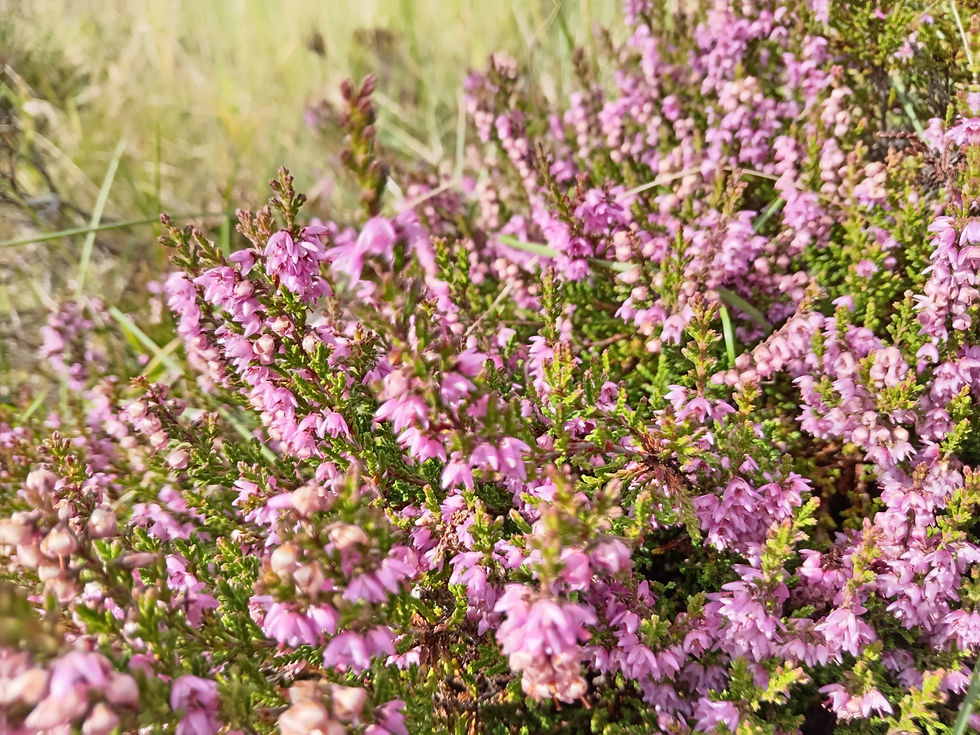Skye's wild plant remedies
- Emma
- 17 juin
- 3 min de lecture
Dernière mise à jour : 28 juil.
Known as the Misty Isle, the Isle of Skye in the north-west of Scotland experiences a mainly mild, wet climate. Due to westerly winds from the sea, this is one of the windiest places in the UK [1]. It has its fair share of storms and horizontal rain. This means that plants (and locals) here have to be fairly hardy to survive. It is also a place of immense beauty and walking in such magnificent scenery is, in itself, a remedy.

For twenty four years, my mother lived in the south part of the isle at the top of a track lined with blackberries (Rubus sp.), rowan (Sorbus sp.) and the occasional wonderfully named bog myrtle (Myrica gale). In the summertime, the unique fresh, slightly disinfectant fragrance of meadowsweet (Filipendula ulmaria) overwhelmed you as you walked down the path to the seafront. This perenial plant, which grows to around a metre high, has deeply veined, serrated, alternate leaves. The small creamy white flowers appear in what appear to be hazy clusters. In August the flowering tops of Meadowsweet were harvested and dried in my mum’s kitchen for use in anti-inflammatory and analgesic infusions due to their content in salicylic acid, the same compound which is used to make aspirin [2].

Up behind my mum’s home was a peat bog, which perhaps isn’t surprising given the amount of rain. Peat forms when the water levels create acidic and anaerobic conditions which prevents plant from fully decomposing. This fragile terrain is home to a wide diversity of plants including Sphagnum mosses. These mosses contribute to the formation of peat by releasing biochemical compounds which hamper the decomposition of organic matter [3]. For centuries, Sphagnum moss was used to dress wounds due to its ability to absorb liquids and its antiseptic properties [4]. Crossing the wide expanse of land behind the house would involve tiptoeing around mosses and bogs. One wild wintry afternoon we ventured up through a storm to the top of a rocky outcrop. Rain lashed down and the gusts of wind occasionally knocked us sideways, yet there was an exhilarant feeling of truly being alive!

Walks would always eventually lead us to the beautiful bright flowers of ling and bell heather (Calluna vulgaris and Erica cinera) blowing in the breeze. This heather, once used as for thatching roofs, stuffing pillows and heating homes, now serves as a colour dye and fragrance in beauty products. In herbalism, both ling and bell heather are used to treat urinary troubles due to their antiseptic, anti-inflammatory and antibacterial properties [5].
To be closer to family, my mum moved back to England. I will miss Skye yet the sweet smell of meadowsweet, the soft sensation of the damp bogland beneath my feet and the calming sight of purple carpets of heather swaying in the wind will remain with me forever. If you ever find yourself in this beautiful place, you'll understand...

For more information on some of the plants mentioned in this post, sign up to the free monthly newsletter here.
[2] Farzaneh, A (2022). Filipendula ulmaria (L.) Maxim. (Meadowsweet): a Review of Traditional Uses, Phytochemistry and Pharmacology. Research Journal of Pharmacognosy. 9. 10.22127/RJP.2021.302028.1781.
[3] Sytiuk, A et al. Morphological and biochemical responses of Sphagnum mosses to environmental changes,
BioRxiv 2020.10.29.360388
[4] https://www.britishbryologicalsociety.org.uk/wp-content/uploads/2020/12/FB110_Ayres_Sphagnum.pdf
[5] Kaunaite V, Phytochemical Diversity and Antioxidant Potential of Wild Heather (Calluna vulgaris L.) Aboveground Parts. Plants (Basel). 2022 Aug 25;11(17):2207.

